August 29, 2024 · 12 min read
Enterprise Project Management Office (EPMO): The Key to Strategic Project Success

Shaimaa Badawi
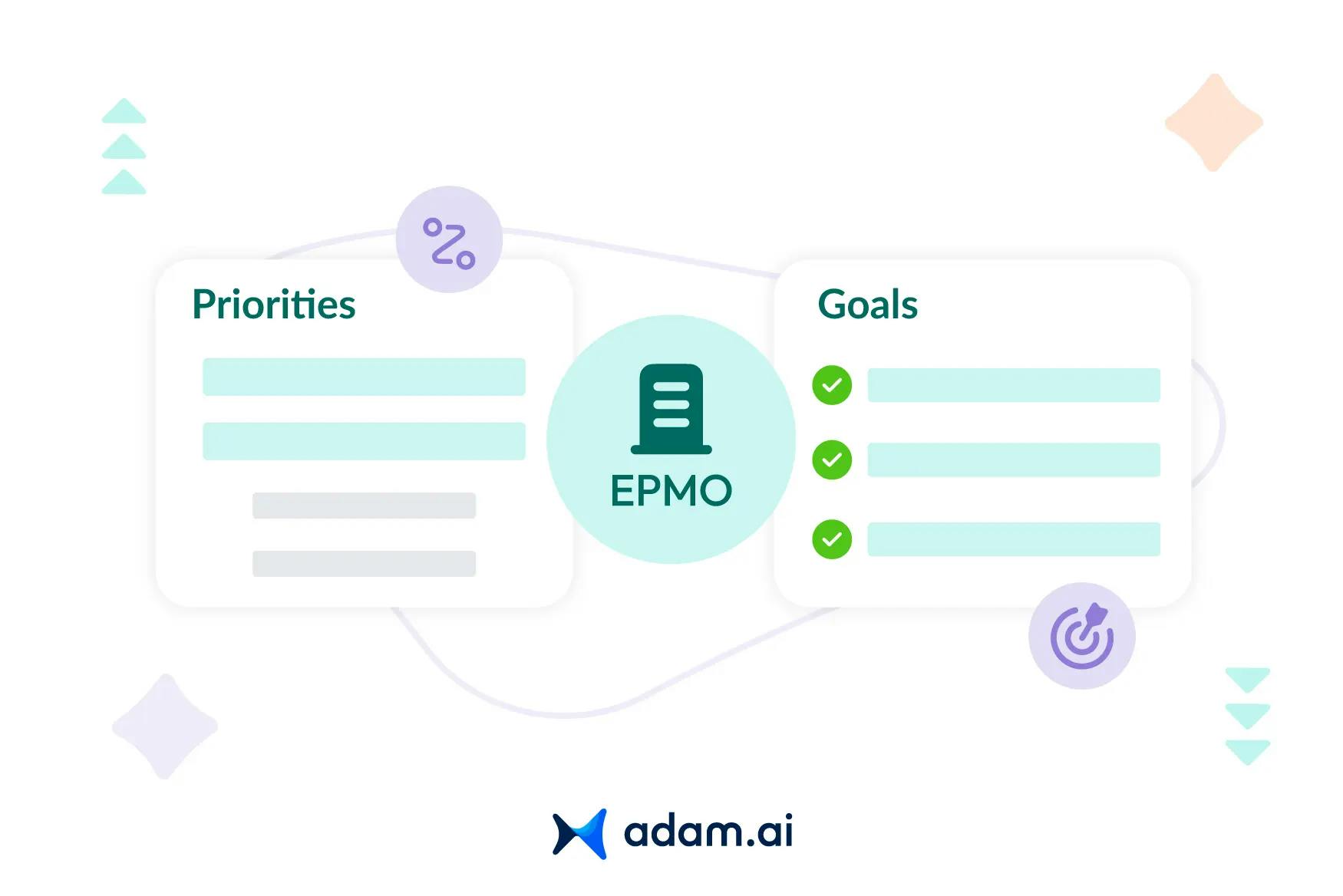
An Enterprise Project Management Office (EPMO) is the backbone of strategic project alignment and resource optimization in large organizations. With multiple projects to manage and executive decisions to drive, the challenge is ensuring efficiency and clear communication at every stage. This article delves into the essential ways EPMOs can enhance project oversight, improve governance, and support better decision-making processes, ensuring that every project contributes to the broader goals of the organization.
What is EPM in project management?
Enterprise Project Management (EPM) is the structured approach to managing and coordinating multiple projects across an organization, ensuring they align with the company’s overarching strategic objectives. Unlike traditional project management, which focuses on individual projects, EPM operates on a larger scale, integrating various projects, programs, and portfolios to optimize resource allocation, improve efficiency, and maximize overall business value.
The core purpose of EPM is to standardize processes across departments, creating a unified framework that ensures all projects contribute to the enterprise’s goals. It involves the implementation of company-wide governance structures, performance metrics, and project management tools that streamline communication and collaboration
What is EPMO in project management?
An Enterprise Project Management Office (EPMO) is a high-level department within an organization that works alongside executives to manage and coordinate the company’s entire portfolio of projects. Its primary role is to ensure that all projects align with the organization’s strategic goals by offering oversight, guidance, and standardized processes.
The EPMO is responsible for overseeing resource allocation, managing risks, and tracking project performance to ensure successful delivery and alignment with business objectives. Operating directly under C-suite executives and the board of directors, the EPMO ensures projects are delivered on time, within budget, and contribute to achieving enterprise-wide benefits.
What is an example of EPMO?
An example of an EPMO can be seen in large organizations such as Microsoft, where the EPMO plays a critical role in overseeing and managing various projects across the entire company.
In a company like Microsoft, where multiple product lines and services are developed simultaneously, the EPMO helps ensure that each project is aligned with the company’s strategic goals. For example, imagine Microsoft working on multiple initiatives, developing new features for Windows, enhancing Azure cloud services, and releasing updates for Office 365, all at the same time. Each of these projects is complex and involves numerous teams, departments, and resources.
The EPMO steps in to provide oversight and governance, ensuring that each project aligns with Microsoft’s broader objectives, such as innovation, customer satisfaction, and market leadership. It does this by standardizing project management processes across departments, implementing best practices, and setting key performance indicators (KPIs) to measure success.
Furthermore, the EPMO monitors resource allocation to ensure that high-priority projects receive the attention they need without overstretching the company’s resources. It also manages risks and tracks performance to make sure projects stay on schedule and deliver the expected business value.
In this case, the EPMO enables Microsoft to run its many projects efficiently, ensuring strategic alignment, resource optimization, and high-level oversight across the organization. This allows the company to innovate, grow, and remain competitive in the tech industry.
What is another name for EPMO?
There are several alternative names for EPMO, each reflecting its strategic role in overseeing projects and ensuring alignment with organizational goals, depending on the structure and focus of the organization:
- Strategic Project Management Office: Highlights the EPMO’s role in aligning projects with the organization's broader strategic goals.
- Enterprise Portfolio Management Office: Focuses on managing the entire portfolio of projects, programs, and initiatives across the enterprise.
- Corporate PMO: A centralized office overseeing projects within a corporate structure, ensuring alignment with corporate objectives.
- Global PMO: Used by organizations with international operations to manage projects and portfolios on a global scale.
- Strategic Portfolio Office: Emphasizes the management of the strategic portfolio and ensuring that all projects align with organizational objectives.
- Enterprise Program Management Office: Sometimes used when the office focuses heavily on managing large, complex programs in addition to individual projects.
What are the activities of EPMO?
The EPMO carries out a variety of key activities that ensure alignment between projects and the organization’s strategic goals. Here is a list of its core activities:
1. Cost management and analysis
The EPMO is responsible for overseeing the financial health of projects, ensuring that they are properly funded and remain on budget throughout their lifecycle. This involves detailed cost forecasting, tracking expenditures, and analyzing variances to make sure projects stay financially viable. The EPMO also provides guidance on how to allocate resources efficiently, maximizing return on investment (ROI) for every project.
2. Resource management
Effective resource allocation is critical to project success. The EPMO ensures that the right people, with the right skills, are assigned to the appropriate projects. It manages the availability of project managers, team members, and other resources, while also resolving any conflicts over resource allocation. This ensures smooth project execution and avoids bottlenecks caused by over-committed resources. Capacity planning is another key part of this function, allowing the EPMO to plan ahead for future resource needs.
3. Risk management
A proactive approach to risk is essential for project success. The EPMO identifies potential risks before projects are approved and continues to monitor them throughout the project’s lifecycle. By assessing the likelihood and impact of these risks, the EPMO develops mitigation strategies to minimize disruption. This ongoing risk analysis helps ensure that projects stay on track and can quickly adapt to challenges, reducing the chances of failure.
4. Performance management
Performance tracking is essential to keep projects aligned with strategic goals. The EPMO defines key performance indicators (KPIs) and metrics that allow project teams to measure their progress and outcomes. By generating regular performance reports, the EPMO provides executives and boards with clear visibility into how well projects are meeting their objectives. This oversight helps ensure continuous improvement and timely decision-making when adjustments are needed.
5. Project governance
The EPMO establishes and enforces governance frameworks that ensure consistency in project execution across the organization. This involves setting standards for decision-making, defining roles and responsibilities, and implementing processes for approvals and reporting. Strong governance helps ensure that all projects adhere to best practices and are aligned with the organization’s strategic goals, while also improving accountability at all levels.
6. Stakeholder communication
Keeping stakeholders informed is a crucial responsibility of the EPMO. This involves regular updates, transparent reporting, and clear communication about project progress, risks, and outcomes. The EPMO ensures that expectations are managed and that stakeholders, from C-suite executives to team members, are all on the same page. This fosters trust and collaboration, ensuring that the organization's goals are met efficiently.
7. Strategic portfolio management
The EPMO oversees the company’s entire portfolio of projects, ensuring that project selection and prioritization align with the broader business strategy. By evaluating the potential impact and value of each project, the EPMO ensures that resources are allocated to initiatives that deliver the most significant benefit to the organization. It also balances the portfolio to avoid over-committing resources to low-priority projects, ensuring strategic alignment across all activities.
8. Business transformation and agility
The EPMO plays a pivotal role in supporting organizational change by promoting business transformation initiatives and ensuring that project teams can respond to evolving priorities. This requires creating a flexible project management approach that can quickly adjust to new business needs or industry changes, enhancing the organization’s agility.
9. Compliance and reviews
Ensuring that all projects adhere to organizational standards and regulatory requirements is another critical EPMO function. The EPMO conducts regular audits and reviews to make sure that projects comply with both internal policies and external regulations. This oversight helps avoid legal risks and ensures that projects meet quality standards, improving overall project outcomes.
10. Competency development
The EPMO is responsible for developing and maintaining project management capabilities within the organization. This includes setting standards for project management practices, offering training, and promoting the use of best practices across teams. By building a strong base of skilled project managers and team members, the EPMO ensures that projects are executed efficiently and effectively, contributing to long-term organizational success.
What are the benefits of EPMO?
The EPMO offers numerous benefits that enhance the overall performance of an organization’s projects and strategic initiatives:
1. Aligns projects with strategic goals
One of the key roles of an EPMO is to ensure that all projects contribute directly to the company’s broader objectives. By overseeing and managing the portfolio of projects, the EPMO ensures that resources and efforts are focused on initiatives that support long-term business success.
2. Strengthens executive support
The EPMO enhances transparency by providing high-level visibility into project progress and outcomes. This clarity helps engage senior executives, making them more likely to back crucial decisions and provide the necessary support to keep projects moving forward.
3. Maximizes resource efficiency
With a bird’s-eye view of all ongoing projects, the EPMO can allocate resources, whether financial, human, or technological, in a more effective manner. By ensuring that the right resources are deployed to the most critical projects, the organization avoids wastage and improves productivity across the board.
4. Fosters better cross-team collaboration
The EPMO plays a key role in breaking down barriers between departments by establishing clear, standardized processes. By encouraging departments to work together under a unified framework, the EPMO promotes better cooperation and communication, leading to more cohesive project execution.
5. Improves decision-making through data
By collecting and analyzing comprehensive data on project performance and risks, the EPMO empowers leaders to make informed, evidence-based decisions. This data-driven approach ensures that decisions are made with the full context of project impact and potential outcomes, helping avoid impulsive or uninformed choices.
6. Standardizes processes for consistency
The EPMO is responsible for creating consistent project management practices across the entire organization. These standardized frameworks make it easier to measure success, ensure accountability, and replicate successful approaches across various projects, leading to more predictable and efficient outcomes.
7. Reduces project risks
With a wide scope of oversight, the EPMO can proactively identify potential risks early in the project lifecycle. By taking a forward-looking approach, the EPMO helps create strategies to minimize these risks, ensuring that projects stay on track and any issues are addressed promptly.
8. Provides a holistic view of the project portfolio
The EPMO offers leadership a clear, enterprise-wide perspective of all ongoing and future projects. This comprehensive view helps the organization make decisions that are in line with long-term growth and success, ensuring that projects are prioritized based on overall business value rather than short-term gains.
9. Boosts project return on investment (ROI)
By focusing on strategic alignment, resource efficiency, and streamlined processes, the EPMO significantly increases the likelihood of project success. This translates to a greater return on investment as the organization is able to complete projects more effectively, on time, and within budget.
What is PMO vs EMPO?
The Project Management Office (PMO) and the Enterprise Project Management Office (EPMO) are both designed to manage and align projects within an organization, but they differ in terms of scope, focus, and hierarchy.
PMO (Project Management Office):
- Scope: A PMO typically operates at the departmental level. It is focused on overseeing projects within specific business units, such as IT, marketing, or finance, and is often comparable to other departmental functions like accounting or HR.
- Focus: The PMO is tactical in nature, dealing with the day-to-day management of projects. It provides team members with tools, methodologies, and resources to ensure projects are completed on time and within scope.
- Role: The PMO works closely with project managers and team members, assisting with planning, execution, and delivery. It is hands-on with each phase of a project, ensuring alignment with departmental goals.
- Interaction: PMOs typically engage more with employees working on specific projects and report to department heads, rather than senior executives.
EPMO (Enterprise Project Management Office):
- Scope: An EPMO operates at the executive level and covers the entire organization’s portfolio of projects. Its focus extends beyond individual departments to ensure that projects align with the company's overarching strategic goals.
- Focus: The EPMO is strategic in nature. It plays a critical role in aligning projects with long-term business objectives, monitoring organizational-wide performance, and providing strategic guidance to senior leadership.
- Role: The EPMO oversees the entire portfolio of projects and ensures that resources are allocated in line with the company's strategic priorities. It is less involved in the day-to-day execution of individual projects and more concerned with the broader impact of these projects on the organization’s success.
- Interaction: EPMOs work closely with C-suite executives and the board, facilitating communication between high-level stakeholders and ensuring projects support corporate goals.
Is EPM the same as ERP?
Enterprise Project Management (EPM) and Enterprise Resource Planning (ERP) systems are distinct but complementary tools that serve different purposes within an organization. While they both aim to improve organizational efficiency, their scope, functionality, and application differ in significant ways.
- Focus and functionality: EPM focuses on managing projects through financial planning, budgeting, and performance tracking. ERP is broader, managing day-to-day operations like manufacturing, HR, and CRM to integrate business functions into one system.
- Cost: EPM is typically more affordable as it deals with financial and operational processes. ERP is more expensive due to its complexity and wide-ranging functionality.
- Scalability: EPM systems scale well for small to medium businesses, offering flexibility in financial oversight. ERP is more suited to large organizations with complex needs across departments.
- Customization: EPM systems are easier to customize due to their narrower focus. ERP systems are harder to modify because changes can affect multiple business areas.
- Flexibility: EPM is highly flexible, adapting quickly to changing business priorities. ERP systems, however, are less flexible due to their integrated nature, making adjustments more difficult.
- Integration: EPM focuses on financial data and integrates with ERP, CRM, and HCM systems. ERP integrates with multiple internal systems to manage various business functions, providing comprehensive end-to-end management.
Elevate your EPMO's efficiency with adam.ai
To support the strategic goals of an EPMO, integrating an intuitive meeting management platform like adam.ai can optimize project oversight, enhance communication, and improve decision-making processes. Here’s how adam.ai can elevate the efficiency of an EPMO:
- Agenda and content management: Seamlessly create and organize agendas for executive-level project meetings. With all relevant project documents, progress reports, and strategic goals in one place, adam.ai ensures that stakeholders have easy access to crucial information, streamlining EPMO operations.

- Action tracking and accountability: EPMOs can keep projects on track by using adam.ai’s action tracking tools. Assign tasks, monitor progress, and ensure that all decisions are captured and followed up on, promoting accountability across multiple project teams.
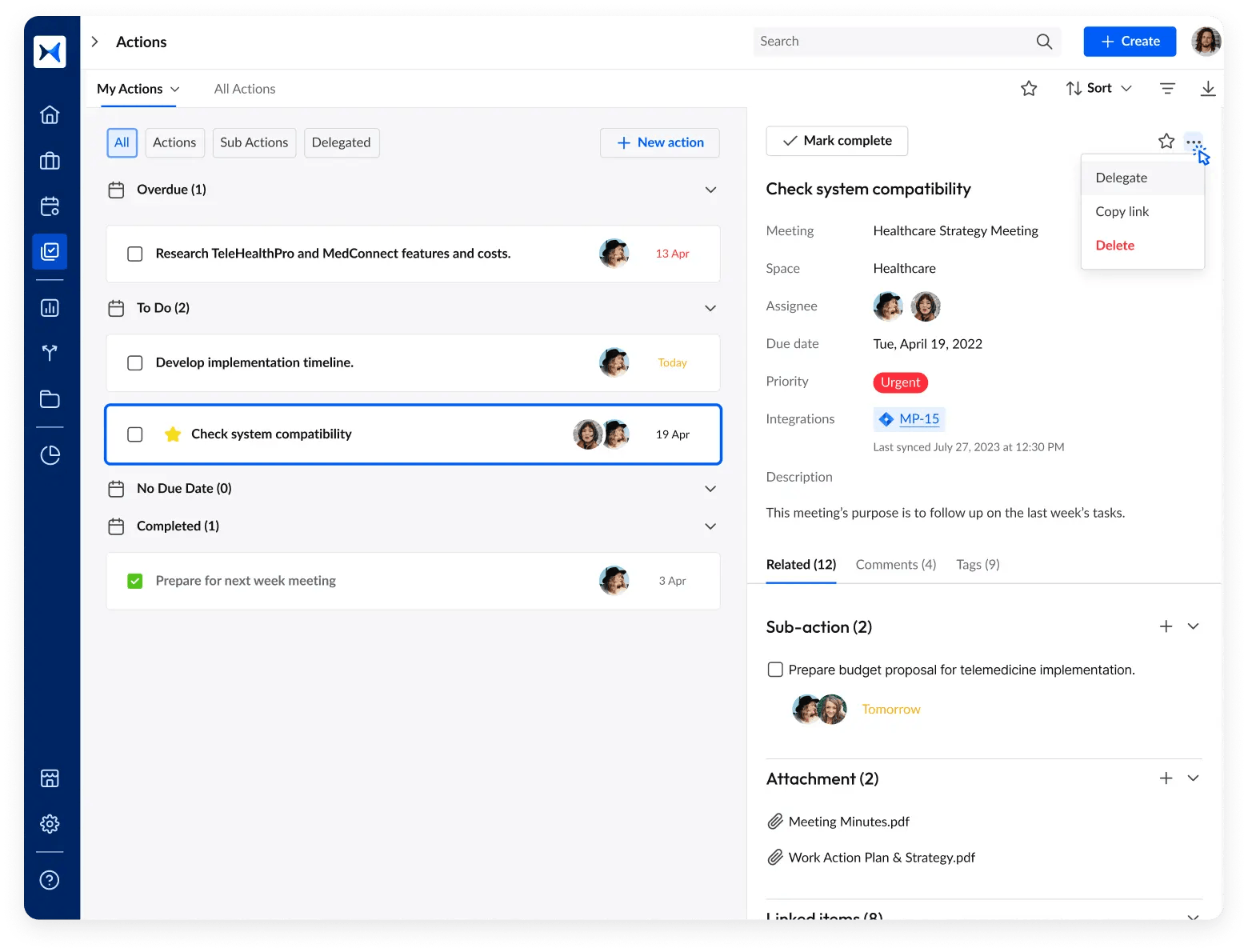
- Multi-project space organization: With adam.ai’s multi-space functionality, EPMOs can organize various project phases, reviews, and strategic meetings in dedicated spaces. This ensures clarity and efficiency when managing complex project portfolios and helps streamline communication across departments.
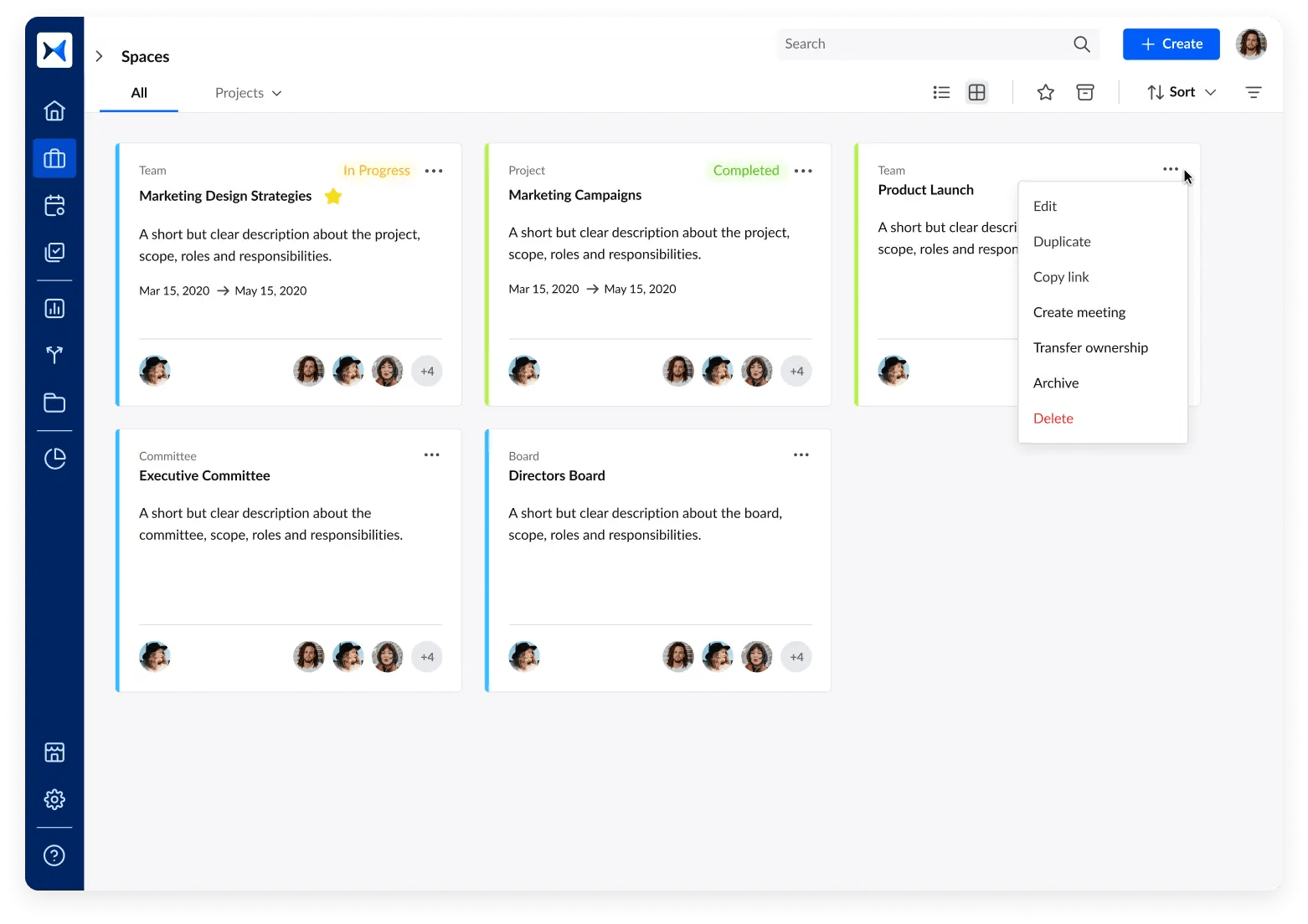
- Automated meeting minutes: Save time by automating meeting minutes and documentation. adam.ai captures discussions, decisions, and action points, ensuring that all project data is well-documented and easily accessible for future reference, simplifying executive reporting.
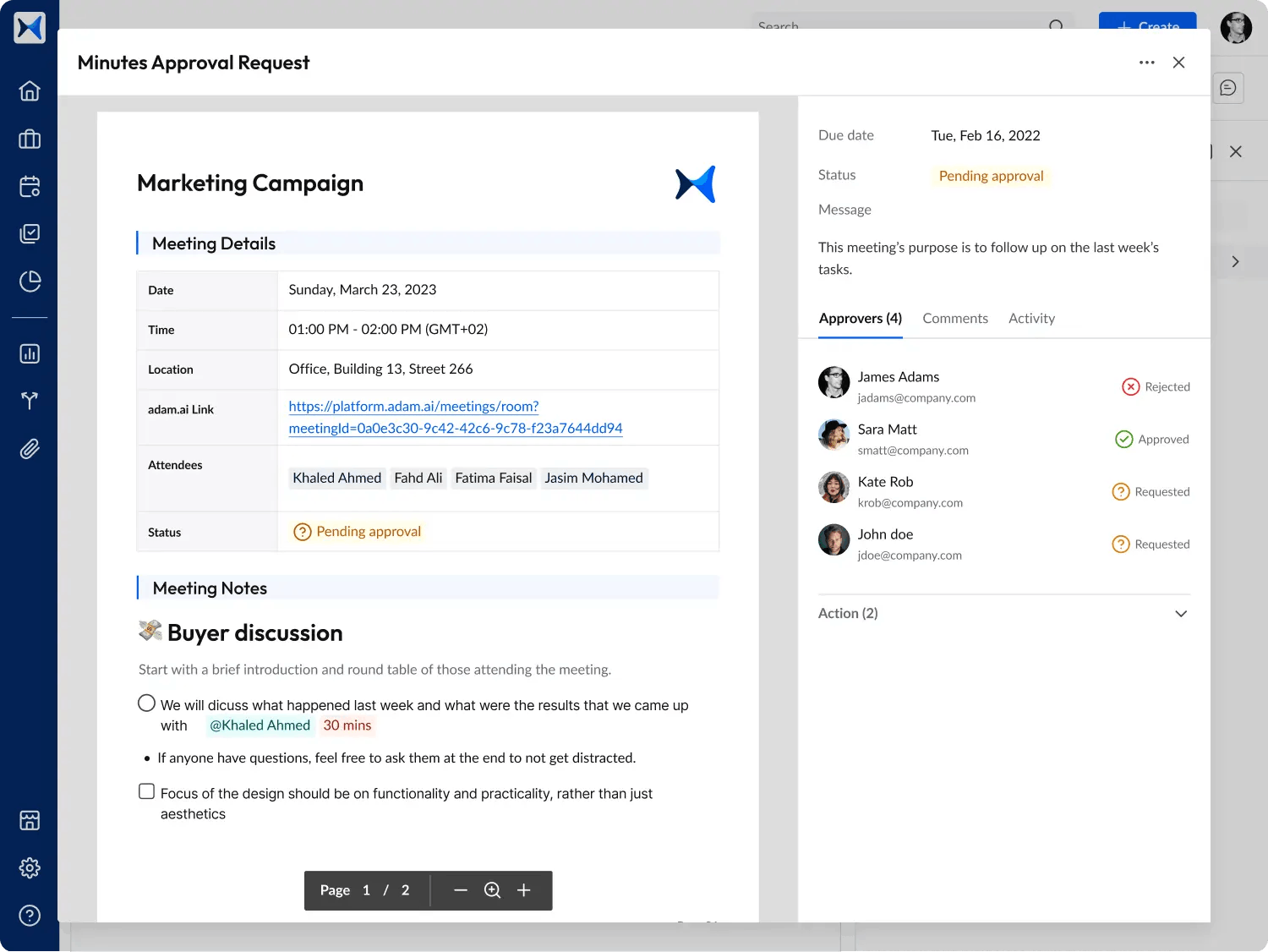
- Voting and decision management: Simplify high-level decision-making with built-in polling and voting features. adam.ai ensures transparency by tracking who voted on critical project decisions, making it easier for EPMOs to manage executive approval processes.
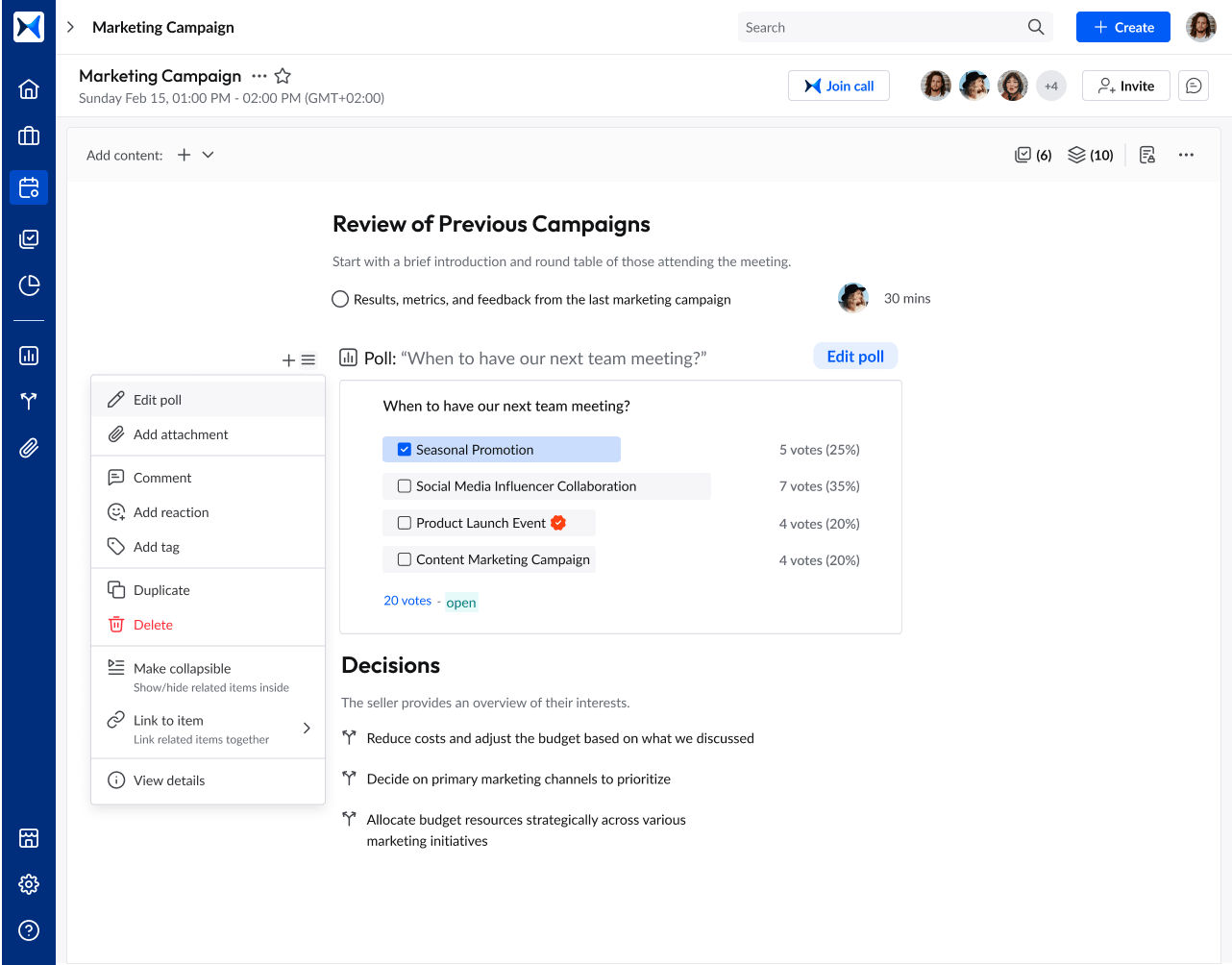
- Data-driven insights: Leverage the platform’s analytics dashboard to monitor project meeting participation, evaluate team performance, and track the progress of ongoing initiatives. This data-driven approach equips EPMOs with the insights needed to make informed, strategic decisions.
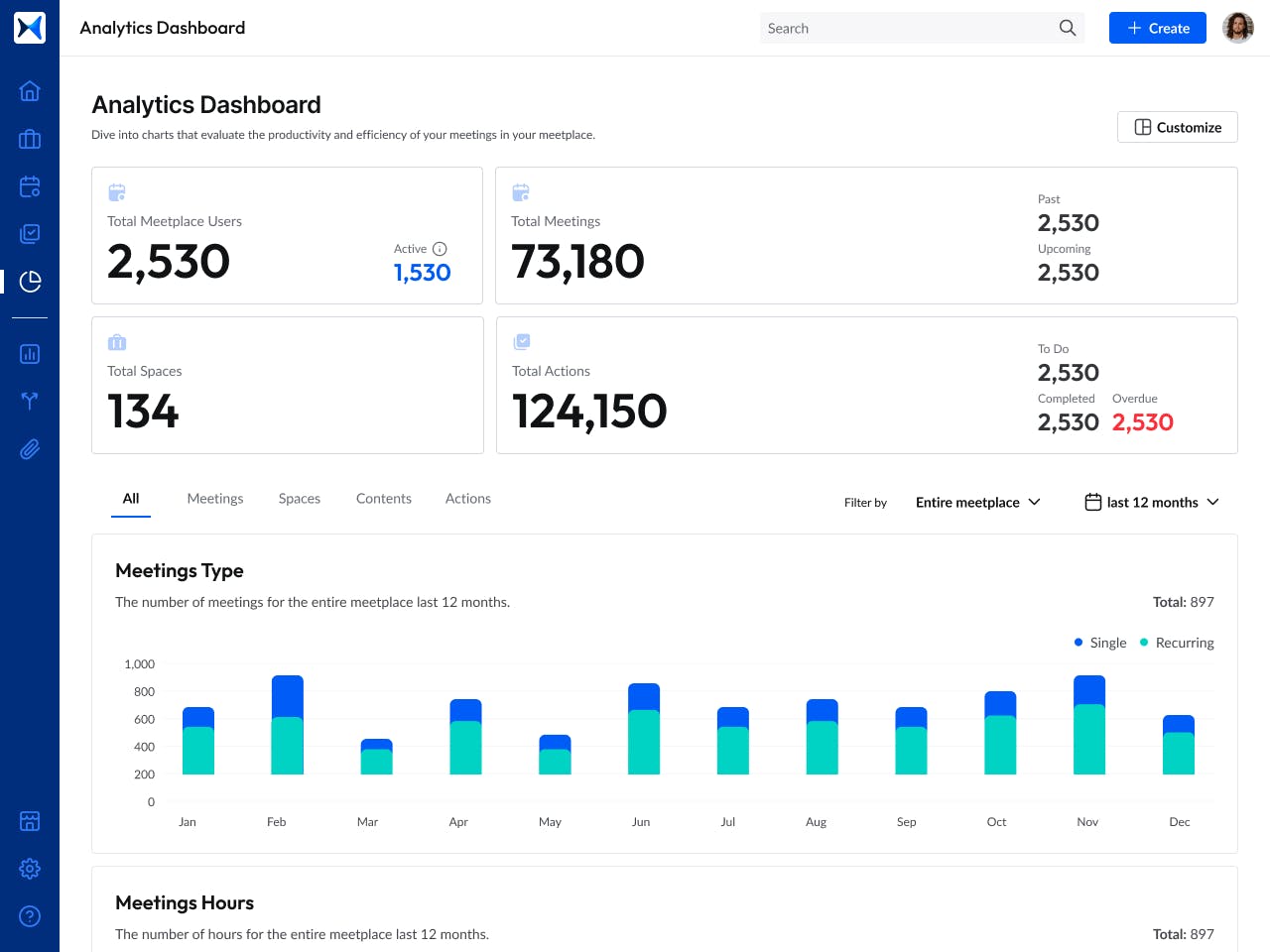
Transform how you conduct critical meetings—From meticulous preparation to effective execution and insightful follow-up, adam.ai integrates comprehensive analytics, full customization, and intuitive interfaces with powerful meeting management tools.
Easy onboarding. Enterprise-grade security. 24/7 dedicated support.
The bottom line
An EPMO is essential for driving strategic alignment and optimizing the management of an organization's project portfolio. Integrating the right tools and processes into your EPMO can transform the way projects are managed, helping you achieve your organizational goals with precision and clarity.
And while there may be multiple solutions available, here is why adam.ai is the meeting management software platform you can trust:
- adam.ai is one of Atlassian Ventures' portfolio companies.
- In the meeting management software category on G2, adam.ai has been ranked a leader and a high performer for successive quarters in the past years.
- adam.ai has been included in the Forrester Report in the AI-enabled meeting technology landscape.
- adam.ai is trusted and used by powerful teams and organizations worldwide for all types of critical meetings, like board, committee, project management, and business development meetings.
- And most importantly, adam.ai integrates with your existing workflow, is SOC2 compliant, provides dedicated support and success, and has a free trial option.
Subscribe to adam.ai blog
Stay ahead with the latest insights—get our newest blog posts, tips, and updates sent straight to your inbox.